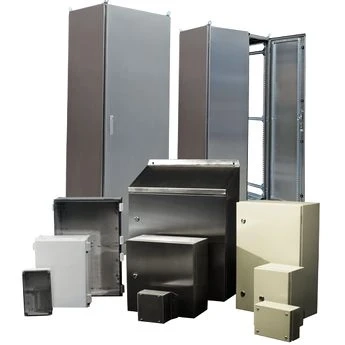Racks organize electronic equipment to standardized assemblies, which make effective use of space as well as other resources. Basically, a rack comprises 2 or 4 vertical mounting rails as well as a supporting framework needed to keep rails in place. Examples are 19-inch racks.
The framework and rails are usually made of aluminium or steel for supporting equipment weighing hundreds of pounds. The rails feature round or square holes that permit you to mount rack equipment onto them using screws.
Rack standards are determined by the width of the rails, vertical and horizontal spacing in mounting holes, and size of equipment cabinets. Such standardization of rack equipment will always be compatible with standard racks.
A 19-inch rack refers to a standardized enclosure meant to mount multiple modules of electronic equipment. Every module features a panel in the front that is 19” wide.
This 19” dimension also includes edges that protrude from all sides of this equipment, permitting the attaching of the module to the frame of the rack using screws. Popular uses of such racks include electrical enclosures used for computers, networking hardware, scientific equipment, audio-visual gear, and telecom equipment.
Equipment made to be mounted on a rack may be usually named as rack-mount chassis or rack-mounted system. Rack-mountable equipment can be mounted by clipping or bolting its front panel to the rack.
The height of modules of electronic items is also standardized in terms of 1.75 inches multiples or a Rack Unit (RU). The standard of rack cabinets of the industry measures 42 RU though 45 RUs are also common.
History
The term rack first appeared in the world of telephony. Since 1911, the name has also been used for railroad signalling. But the early rack versions were never standardized.
The rack format of 19-inch, with 1.75 inches rack units was set up as an AT&T (a leading technology company) standard in 1922 for reducing the space needed for termination and repeater equipment used in central offices of telephone companies.
Early repeaters since 1914 tended to be installed in an unplanned fashion in cabinets, shelves, and wooden boxes. With the start of serial production, they were constructed into customized racks, one for each repeater.
However, with regard to the network’s speedy growth, the AT&T engineering department took up a methodical redesign. This resulted in a series of factory-assembled, modular panels that were designed to be mounted onto vertical supports that are spaced 19 and a half inches between centres.
The format of a rack of 19-inch has stayed constant even as the technology of systems mounted on it has been transformed tremendously, and the fields on which racks may be applied have also expanded. The arrangement of standard racks of 19 inches is used widely in computing, telecommunications, entertainment, video, audio, and some other industries.
19-inch racks of 4-post or 2-post type hold the majority of equipment of modern Internet Service Provider (ISP) facilities, data centres, and server rooms of corporations that are designed professionally. They enable configurations of dense hardware without needing shelving or occupying too much floor space.
19-inch server racks are standardized size frames or enclosures used to mount equipment and are typically used for storing equipment of computer servers. Such server racks permit dense hardware configurations that optimize space. In case you need only a small number of servers, 19-inch server racks are the best economic choice because of low upfront costs. Server racks store and organize crucial IT systems that can be configured for supporting an extensive range of needs.
A 19-inch rack is often used to store professional video and audio equipment like amplifiers and sound mixers. Another common use of rack-mounted equipment is hardware for automation, control, and industrial power. This rack is therefore regarded as highly useful electrical enclosures.



